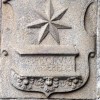- Accede I
- Regístrate I
- carrito
Historia y tradición apostólica
El hallazgo de la tumba del Apóstol, ocurrido hacia la segunda o tercera década del siglo IX, constituía el final lógico de una tradición oral y escrita que, tras la muerte de Jesucristo, ubicaba a Santiago el Mayor como evangelizador en tierras de la antigua Hispania, según sugerían el Breviarum Apostolorum en el siglo VI-VII y los textos firmados por el anglosajón Beda Venerabilis y el asturiano Beato de Liébana en el siglo octavo. Al hecho histórico de la decapitación del Apóstol por Herodes Agrippa en el año 44, siguen las explicaciones proporcionadas por el Códice Calixtino o la Legenda Aurea para dar fe de su traslado a tierras del confín continental, aquellas en las que había transmitido las enseñanzas de Cristo. El cuerpo sin vida de Santiago habría sido conducido por dos jóvenes discípulos en barco tripulado por ángeles, que cruzó el Mediterráneo y subió por la costa portuguesa hasta el puerto romano de Iria en la provincia de Gallaecia. Allí, tras una serie de hechos milagrosos, Santiago habría sido finalmente sepultado en el monte Liberum Donum, en un lugar vagamente designado como Arcis Marmoricis.
Casi ochocientos años más tarde –continúa la tradición – un ermitaño habría avistado luces celestiales que lo condujeron hacia el lugar sagrado, cuya historia permanece en el misterio durante los años de la desintegración del Imperio Romano, la constitución de un reino suevo y la dominación visigótica. El eremita habría avisado a Teodomiro, obispo de Iria, sobre el descubrimiento, y el Rey Alfonso II hizo construir ya entonces una pequeña iglesia, que dejó bajo la custodia de monjes benedictinos. Antes de terminar el siglo IX, Alfonso III encargaba la construcción de una basílica mayor, digna del acontecimiento que comenzaba a mover a los fieles de Europa.
La noticia coincidía con un importante momento político para la consolidación del reino astur-galaico, en cuyo territorio ocurría el hallazgo. Expulsadas las tropas musulmanas del norte de España, era menester repoblar el territorio y tender hacia el resto de Europa una sólida red para la circulación de personas, mercancías e ideologías. En la titánica tarea sería decisivo el hecho de contar con un centro religioso de la talla de Roma o Jerusalén, que de alguna manera “independizaba” espiritualmente al reino naciente del extendido imperio de Carlomagno.










